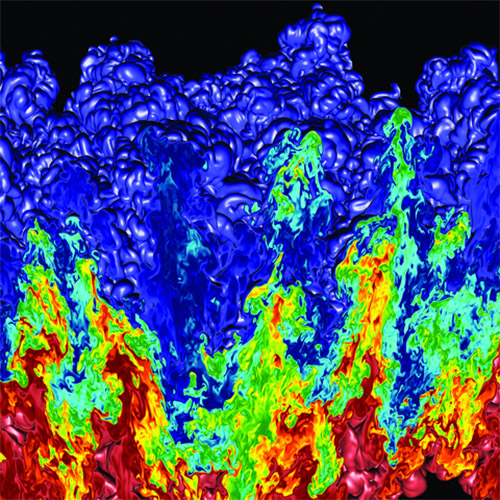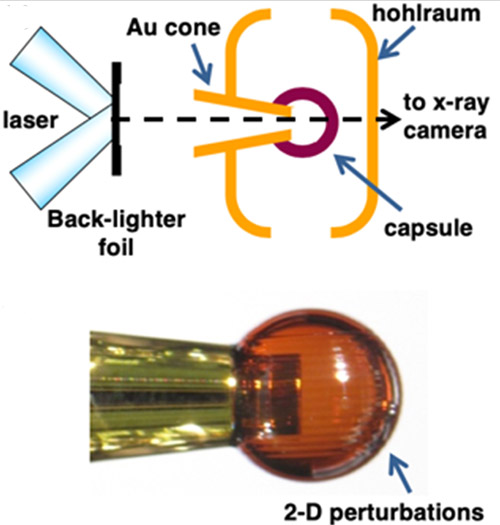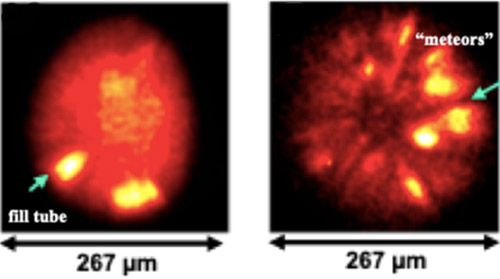Improving Understanding of NIF Implosion Instabilities
January 28, 2020
Long before NIF began operations in 2009, researchers knew one of their biggest challenges to achieving fusion ignition would be finding ways to control the instabilities caused by forcing materials with different densities together at high speeds.
Now, thanks to years of focused studies, scientists have reached a much better understanding of the causes and nature of these instabilities and are devising creative new methods for dealing with them. The results of those studies were reported in a recent Plasma Physics and Controlled Fusion paper by LLNL physicist Vladimir Smalyuk and colleagues.
 Simulation of Rayleigh-Taylor hydrodynamic instability created on LLNL’s BlueGene/L supercomputer using the MIRANDA code. When fluids or plasmas of different densities, such as the material in an imploding NIF target capsule’s outer layers and the hydrogen fusion fuel inside the capsule, are accelerated together or shocked, they begin to interpenetrate at their boundary. A variety of factors can cause these instabilities.
Simulation of Rayleigh-Taylor hydrodynamic instability created on LLNL’s BlueGene/L supercomputer using the MIRANDA code. When fluids or plasmas of different densities, such as the material in an imploding NIF target capsule’s outer layers and the hydrogen fusion fuel inside the capsule, are accelerated together or shocked, they begin to interpenetrate at their boundary. A variety of factors can cause these instabilities. “Hydrodynamic (fluid) instabilities are a major factor in the degradation of inertial confinement fusion (ICF) implosions,” the researchers said. “Any (laser) drive asymmetries and (target capsule) surface imperfections are amplified by the hydrodynamic instabilities during the implosion resulting in a distorted (capsule) shell with reduced hot-spot temperature, compression, and neutron yield. Understanding and mitigation of the instabilities are critical to achieving ignition.”
In indirect-drive ICF experiments on NIF, the facility’s 192 powerful laser beams impact the inner surface of an eraser-sized cylinder called a hohlraum, generating x rays that blow off the surface of a tiny capsule filled with deuterium-tritium (DT) fuel. The resulting high-velocity implosion compresses and heats the fuel to hot-spot temperatures higher than the core of the Sun, forcing the hydrogen atoms to fuse and release energy in the form of neutrons and alpha particles (helium nuclei).
Hydrodynamic instabilities, known as Rayleigh-Taylor (RT) and Richtmyer–Meshkov (RM) instabilities, disrupt the smooth, symmetric implosions essential to reach the conditions required for ignition—when the fusion reactions produce more energy than the energy absorbed by the fuel. They also can exacerbate the mixing of capsule material with fusion fuel, degrading compression and neutron yield. The studies have identified a variety of adverse factors, or perturbations, that contribute to these instabilities.
“The seeds for the instability growth,” the researchers said, “include capsule surface roughness, drive non-uniformities and asymmetries, and engineering features such as membranes (or ‘tents’) used to hold the capsule inside the hohlraum and a fill tube used to supply DT fuel inside the capsule. The instability growth can cause a shell to break up and ablator material to mix with the DT fuel resulting in reduced neutron performance of the implosion.”
Focused Experiments and New Platforms
To reach those conclusions, researchers conducted a series of focused experiments at NIF and at the OMEGA laser at the University of Rochester. OMEGA shock-propagation experiments helped to identify and measure many of the perturbations in plastic, beryllium, and high-density carbon (diamond) ablators.
 (Above) Schematic of the hydrodynamic growth radiography (HGR) platform. (Below) Photo of the driven capsule mounted on a gold cone and equipped with pre-imposed 2D perturbations (“ripples”).
(Above) Schematic of the hydrodynamic growth radiography (HGR) platform. (Below) Photo of the driven capsule mounted on a gold cone and equipped with pre-imposed 2D perturbations (“ripples”). The hydrodynamic growth radiography (HGR) platform used x-ray radiography at NIF to measure instability linear growth factors of pre-imposed 2D and 3D sinusoidal perturbations, or “ripples.” This platform was then extended to measure the growth of modulations from capsule surface roughness and engineering features such as fill tubes and tents.
More recently, new experimental platforms were developed to measure instability growth at the interface between the ablator and the inner layer of cryogenically cooled DT; this can potentially become unstable due to RT instability leading to ablator-fuel mix. To address this, the HGR platform was extended to include DT layers in order to perform instability measurements at the ablator–ice interface in the acceleration phase of implosions. In the deceleration phase, complementary “self-emission” and “self-backlighting” platforms were developed to measure asymmetries and perturbations near peak compression.
Smalyuk, the lead author of the Plasma Physics and Controlled Fusion paper, said the studies showed that the combination of high hydrodynamic instability growth and the rapid convergence of fusion fuel toward the hot spot has been a major factor in NIF’s inability to reach ignition.
 (Left) X-ray images from a self-emission experiment show the tent (the circular ring) and fill-tube perturbations; the images were enhanced by “doping” a layer of high-density carbon (HDC) with a small amount of tungsten on the inner layer of the HDC target capsule. (Right) In an experiment with an increased number of “meteors,” the neutron yield was degraded by about a factor of two due the higher level of visible perturbations.
(Left) X-ray images from a self-emission experiment show the tent (the circular ring) and fill-tube perturbations; the images were enhanced by “doping” a layer of high-density carbon (HDC) with a small amount of tungsten on the inner layer of the HDC target capsule. (Right) In an experiment with an increased number of “meteors,” the neutron yield was degraded by about a factor of two due the higher level of visible perturbations. One recently discovered challenge, for example, is the presence of bright spots called “meteors” in the hot spot. The meteors, which can cool the implosion, may be caused by target capsule material being injected deep into the hot spot. This could be due to small-scale defects on the capsule surface as well as crystalline “microstructures” in the capsule layers that can seed further perturbation growth. Researchers are investigating ways to improve capsule performance through new fabrication techniques and innovative, more stable capsule designs.
In addition, Smalyuk said, “we have other ways to support the capsule without the tent. We have to be smarter in how we design our experiments. Being more aggressive, strongly stabilizing instability, reducing initial perturbations is a way to go,” he said. “That’s what we’re pushing in the current campaign.”
Smalyuk was joined on the paper, “Review of hydrodynamic instability experiments in inertially confined fusion implosions on the National Ignition Facility,” by LLNL colleagues Chris Weber, Nino Landen, Suzanne Ali, Benjamin Bachmann, Peter Celliers, Eddie Dewald, Ayala Fernandez, Bruce Hammel, Gareth Hall, Andrew MacPhee, Louisa Pickworth, Harry Robey, Kevin Baker, Laura Berzak Hopkins, Dan Casey, Dan Clark, Laurent Divol, Tilo Döppner, John Edwards, Sean Felker, John Field, Steve Haan, Alex Hamza, Mark Herrmann, Warren Hsing, Shahab Khan, Jeremy Kroll, Sebastien LePape, Bruce MacGowan, David Martinez, Laurent Masse, Jose Milovich, Alastair Moore, Abbas Nikroo, Arthur Pak, Prav Patel, Luc Peterson, Kumar Raman, Bruce Remington, and Michael Stadermann along with Lane Carlson, Emmanuel Alfonso, Jay Crippen, Mike Farrell, Martin Havre, M. P. Mauldin, Neal Rice, and Michael Schoff of General Atomics and John Kline and Eric Loomis of Los Alamos National Laboratory.
—Charlie Osolin
Follow us on Twitter: @lasers_llnl



